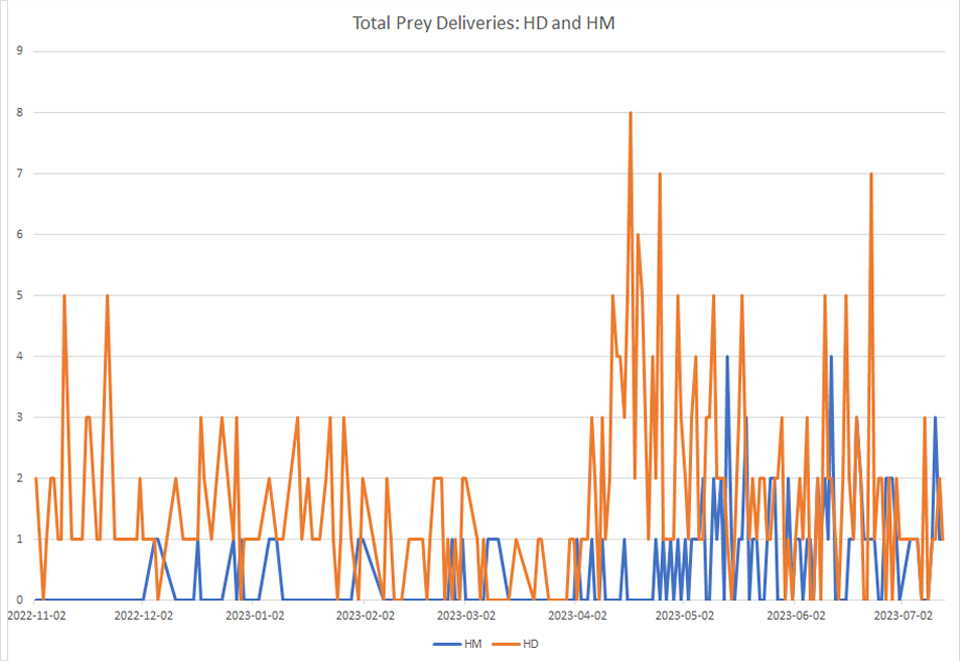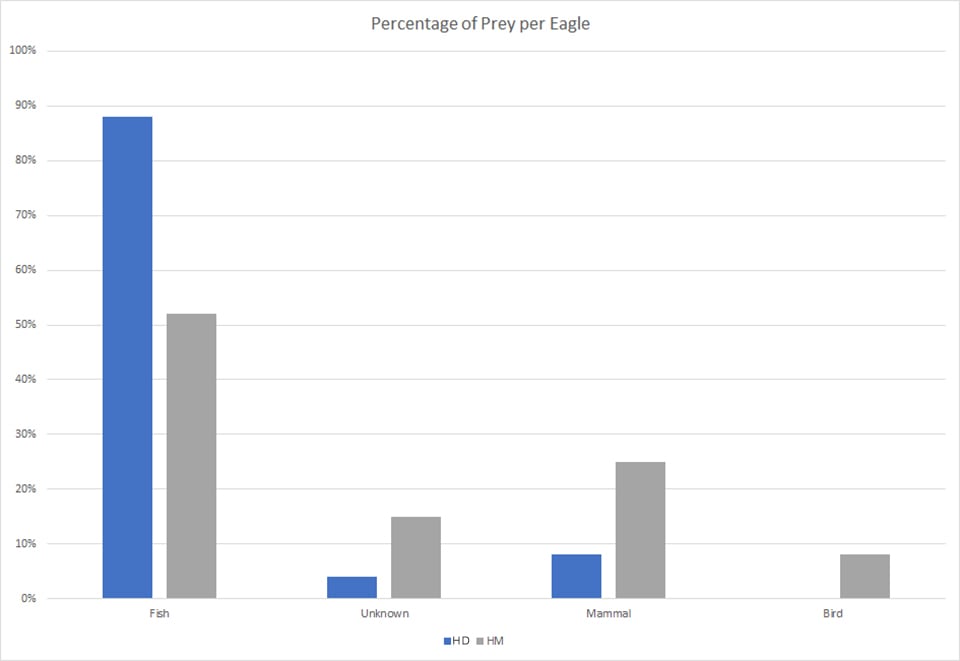Trick or treat/smell our feet/give us something good to eat!
Happy Halloween, everyone! As part of today’s spooky candy-filled festivities, we wanted to pass out some fish, a few squirrels, and a little information about what HD, HM, and DH2 enjoyed for dinner last year!
Between November 2, 2022 and July 13, 2023, our volunteers documented 407 meals. As we’ve seen at other nests, HD was a master provider, bringing in 316 meals to HM’s 91. He was especially active during DH2’s first three weeks of life, when he delivered an incredible 71 meals to feed DH1. During the same time period, HM delivered 4 meals. This discrepancy reflects their very different roles in early nest life. The work of brooding and protecting the immediate vicinity of the nest largely falls to HM, while the work of providing food and patrolling the pair’s territory largely falls to HD.
 2023: Prey Deliveries to the Decorah Nest by Date
2023: Prey Deliveries to the Decorah Nest by Date
While HM’s pan-tree provisioning never exceeded HD’s, her prey deliveries began to ramp up after May 4th. Between May 4 and July 13, HM delivered 69 meals, or 76% of her meal deliveries. This is quite similar to what we’ve seen elsewhere. Four-week-old eaglets still seem to appreciate parental company, but no longer need constant brooding. Absent parents and dinner drops give them a chance to explore and develop skills on their own, while hungry almost-fledglings can be a threat to toes, talons, and ears!
What’s on the Menu? Percentage of Prey by Type
Bald Eagles take a wide variety of prey, but they are especially adapted for catching fish and eat a lot of them. HD and HM followed a pretty standard eagle menu plan, with prey percentages that broke down like this:
| Prey Group | HD (adult male eagle) | HM (adult female eagle) |
| Fish | 88% | 52% |
| Mammal | 8% | 25% |
| Unknown | 4% | 15% |
| Bird | Less than 1% | 8% |
 2023: Percentage of Prey by Type
2023: Percentage of Prey by Type
HM brings in fewer fish and more mammals and UFOs (Unidentified Food Objects) than her mate. This could be because she’s larger and can carry heavier prey, but I wonder if HD’s smaller size, lower weight, and compact footpad make him better suited to snatching and holding on to quick, slippery fish than his mate. While mammals (especially young, inexperienced mammals) should be more abundant at about the time that HM’s provisioning activities increase, HM did not start bringing in more mammals when she started hunting. This indicates that prey choice is not only about prey availability.
HD’s outsized role in provisioning during DH2’s early life also meant that the eaglet got a very high percentage of fish in early development. The fish were usually fresh, high in fat and calories, and pretty easy to tear into tiny edible chunks. Eaglets are robust and I’m sure HM would have made due with whatever HD hauled in. But I have to think that an abundant supply of fish makes everything easier: hunting, delivering, butchering, and feeding a tiny little bobblehead that can’t quite hold its head steady or expel a pellet.
Since it’s Halloween, I thought I’d close with a treat for you and for DH2! Have fun, my pretties – and keep your eyes on the skies! You never know who – or what! – might turn up!
 The Raptor Resource Project
The Raptor Resource Project The Raptor Resource Project
The Raptor Resource Project